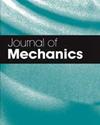Investigating fracture toughness of graphene epoxy nanocomposites using single edge notched bending specimens
IF 1.8
4区 工程技术
Q3 MECHANICS
引用次数: 1
Abstract
The purpose of this study was to examine the fracture toughness of epoxy-based graphene nanocomposites. The single edge notched bending (SENB) samples with precrack tips were created by either tapping or sliding methods. For the tapping method, a single tap was conducted on a razor blade such a crack with a length of 2 mm was instantly propagated. For the sliding method, a razor blade was slid forward and backward into the samples, and a crack was generated with the blade edge. The SENB samples with graphene loadings (0.15 and 0.3 wt%) were subjected to three-point bending tests to evaluate fracture toughness. Results indicated that the graphene loading did not considerably affect the fracture toughness of the samples with tapping-induced precrack tips. However, the fracture toughness of the samples with sliding-induced precrack tips decreased as the graphene loading increased. For the 0.3-wt% graphene nanocomposites, the fracture toughness levels of the samples with sliding- and tapping-induced precrack tips were equal. In order to explicate the experimental results, the plastic zone sizes around the crack tip were evaluated using finite element analysis. For the sharp precrack tips (tapping method), the plastic zone was comparatively small (brittle behavior); hence, the effect of graphene on the inception of crack extension was minimal. Nevertheless, for blunt crack tips (sliding method), the plastic zone was larger and the size decreased as graphene loading increased; thus, the fracture behavior measured from the sliding method was dramatically influenced by the graphene loading.利用单刃缺口弯曲试样研究石墨烯环氧纳米复合材料的断裂韧性
本研究的目的是检测环氧基石墨烯纳米复合材料的断裂韧性。采用敲击法或滑动法制作了带有预裂纹尖端的单边缘缺口弯曲(SENB)样品。对于敲击方法,在剃须刀片上进行一次敲击,使得长度为2mm的裂纹立即扩展。对于滑动方法,将刀片向前和向后滑动到样品中,刀片边缘产生裂纹。对石墨烯负载量(0.15和0.3wt%)的SENB样品进行三点弯曲试验,以评估断裂韧性。结果表明,石墨烯负载量对具有轻敲诱导预裂纹尖端的样品的断裂韧性没有显著影响。然而,具有滑动诱导预裂纹尖端的样品的断裂韧性随着石墨烯负载的增加而降低。对于0.3-wt%石墨烯纳米复合材料,具有滑动和轻敲诱导的预裂纹尖端的样品的断裂韧性水平相等。为了解释实验结果,使用有限元分析对裂纹尖端周围的塑性区尺寸进行了评估。对于尖锐的预裂纹尖端(攻丝法),塑性区相对较小(脆性行为);因此,石墨烯对裂纹扩展开始的影响是最小的。然而,对于钝裂纹尖端(滑动法),随着石墨烯负载量的增加,塑性区更大,尺寸减小;因此,滑动法测量的断裂行为受到石墨烯负载的显著影响。
本文章由计算机程序翻译,如有差异,请以英文原文为准。
求助全文
约1分钟内获得全文
求助全文
来源期刊

Journal of Mechanics
物理-力学
CiteScore
3.20
自引率
11.80%
发文量
20
审稿时长
6 months
期刊介绍:
The objective of the Journal of Mechanics is to provide an international forum to foster exchange of ideas among mechanics communities in different parts of world. The Journal of Mechanics publishes original research in all fields of theoretical and applied mechanics. The Journal especially welcomes papers that are related to recent technological advances. The contributions, which may be analytical, experimental or numerical, should be of significance to the progress of mechanics. Papers which are merely illustrations of established principles and procedures will generally not be accepted. Reports that are of technical interest are published as short articles. Review articles are published only by invitation.
 求助内容:
求助内容: 应助结果提醒方式:
应助结果提醒方式:


